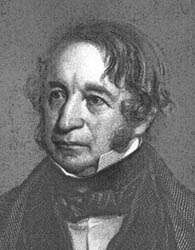Nathan Appleton
| Nathan Appleton | |
|---|---|
 | |
| Member of the U.S. House of Representatives from Massachusetts's 1st district | |
|
In office March 4, 1831 – March 3, 1833 | |
| Preceded by | Benjamin Gorham |
| Succeeded by | Benjamin Gorham |
|
In office June 9, 1842 – September 28, 1842 | |
| Preceded by | Robert Charles Winthrop |
| Succeeded by | Robert Charles Winthrop |
| Personal details | |
| Born |
October 6, 1779 New Ipswich, New Hampshire |
| Died |
July 14, 1861 (aged 81) Boston, Massachusetts |
| Political party |
National Republican Whig |
Nathan Appleton (October 6, 1779 – July 14, 1861) was an American merchant and politician.
Biography
Appleton was born in New Ipswich, New Hampshire, the son of Isaac Appleton and his wife Mary Adams. Appleton's father was a church deacon, and Nathan was brought up in the "strictest form of Calvinistic Congregationalism."[1] He was educated in the New Ipswich Academy. He then entered Dartmouth College in 1794, however, that same year he left college to begin mercantile life in Boston, Massachusetts in the employment of his brother, Samuel Appleton (1766–1853), a successful and benevolent man of business, with whom he was in partnership from 1800 to 1809.[2]
In 1813 Appleton co-operated with Francis Cabot Lowell, Patrick T. Jackson, Paul Moody and others in introducing the power loom and the manufacture of cotton on a large scale into the United States, a factory being established at Waltham, Massachusetts in 1814.[3] The Waltham mill employed the first power loom ever used in the United States. This proving successful, he and others purchased the water-power at Pawtucket Falls, and he was one of the founders of the Merrimac Manufacturing Company. The settlement that grew around these factories developed into the city of Lowell, of which in 1821 Mr. Appleton was one of the three founders. In a pamphlet entitled The Origin of Lowell, Appleton wrote of the mills: "The contrast in the character of our manufacturing population with that of Europe has been the admiration of most intelligent strangers. The effect has been to more than double the wages of that description of labor from what they were before the introduction of this manufacture".[4]
Appleton was a member of the general court of Massachusetts in 1816, 1821, 1822, 1824 and 1827. In 1831-1833 and also 1842 he served in the United States House of Representatives,[3] in which he was prominent as an advocate of protective duties. He was also a member of the Academy of Science and Arts, and of the Massachusetts Historical Society. He published speeches and essays on currency, banking, and the tariff, of which his Remarks on Currency and Banking (enlarged ed., 1858) is the most celebrated, as well as his memoirs on the power loom and Lowell. He was elected a Fellow of the American Academy of Arts and Sciences in 1842,[5] and elected a member of the American Antiquarian Society in 1854.[6]
Family

Appleton married Maria Theresa Gold on April 13, 1806. Two months later, he hired the artist Gilbert Stuart to paint portraits of the newlyweds.[7] The couple had five children: Thomas Gold Appleton (1812–1884); Mary "Molly" Appleton (1813-?), who married British colonial governor Robert James Mackintosh; Charles Sedgwick Appleton (1815–1835); Frances "Fanny" Elizabeth Appleton (1817–1861), who married the poet Henry Wadsworth Longfellow; George William Appleton (1826–1827), who died in infancy. The Appletons attended Federal Street Church.
Maria Theresa Appleton died of tuberculosis in 1833.[8] Nathan Appleton remarried on January 8, 1839, to Harriot Coffin Sumner (1802–1867), the daughter of Jesse Sumner, a Boston merchant, and Harriot Coffin of Portland, Maine. They had three children: William Sumner Appleton (1840–1903); Harriet Sumner Appleton (1841–1923), who married Union Army officer Greely S. Curtis; Nathan Appleton Jr. (1843 - 1906). Nathan Appleton St. was the grandfather of William Sumner Appleton Jr. (1874 - 1947).
His daughter Fanny married Henry Wadsworth Longfellow in 1843. As a wedding gift, Appleton purchased the house in which Longfellow had been renting rooms, now known as the Longfellow House–Washington's Headquarters National Historic Site.[9] He paid $10,000 for the home.[10] Frances wrote to her brother Thomas on August 30, 1843: "We have decided to let Father purchase this grand old mansion",[11] which was also a former headquarters of George Washington during the American Revolutionary War. Nathan Appleton also purchased the land across the street, as Longfellow's mother wrote, "so that their view of the River Charles may not be intercepted".[12]
Appleton was also the cousin of William Appleton.

Fanny Appleton died on July 10, 1861, after accidentally catching fire;[13] her father was too sick to attend her funeral. Appleton died the next day, in Boston, on July 14, 1861.[14]
See also
- Nathan Appleton Residence, Beacon Street, Boston
Notes
- ↑ "Nathan Appleton". 5.uua.org. Retrieved April 7, 2013.
- ↑ Chisholm 1911, pp. 224–225.
- 1 2 Chisholm 1911, p. 225.
- ↑ Tharp 1973, p. 103.
- ↑ "Book of Members, 1780-2010: Chapter A" (PDF). American Academy of Arts and Sciences. Retrieved 22 April 2011.
- ↑ American Antiquarian Society Members Directory
- ↑ Tharp 1973, p. 4.
- ↑ Calhoun 2004, p. 119.
- ↑ Wilson, Susan (2000), Literary Trail of Greater Boston, Boston: Houghton Mifflin Company, p. 109, ISBN 0-618-05013-2
- ↑ Calhoun 2004, p. 167.
- ↑ Tharp 1973, p. 239.
- ↑ Tharp 1973, p. 240.
- ↑ Irmscher, Christoph (2008), Longfellow Redux, University of Illinois, p. 9, ISBN 978-0-252-03063-5
- ↑ Tharp 1973, p. 302.
References
-
 Wilson, James Grant; Fiske, John, eds. (1900). "Appleton, Samuel". Appletons' Cyclopædia of American Biography. New York: D. Appleton.
Wilson, James Grant; Fiske, John, eds. (1900). "Appleton, Samuel". Appletons' Cyclopædia of American Biography. New York: D. Appleton. - Calhoun, Charles C. (2004), Longfellow: A Rediscovered Life, Boston: Beacon Press, ISBN 0-8070-7026-2
- Tharp, Louise Hall (1973), The Appletons of Beacon Hill, Boston: Little, Brown and Company
- Attribution
-
 This article incorporates text from a publication now in the public domain: Chisholm, Hugh, ed. (1911). "Appleton, Nathan". Encyclopædia Britannica. 2 (11th ed.). Cambridge University Press. pp. 224–225. Endnotes:
This article incorporates text from a publication now in the public domain: Chisholm, Hugh, ed. (1911). "Appleton, Nathan". Encyclopædia Britannica. 2 (11th ed.). Cambridge University Press. pp. 224–225. Endnotes:
- Winthrop, Robert C. (1861), Memoir of Nathan Appleton, Boston
- Hale, Susan (1885), Life and Letters of Thomas Gold Appleton, New York
External links
- Nathan Appleton Dictionary of Unitarian & Universalist Biography
- United States Congress. "Nathan Appleton (id: A000269)". Biographical Directory of the United States Congress.
-
 "Appleton, Nathan". The American Cyclopædia. 1879.
"Appleton, Nathan". The American Cyclopædia. 1879.
| United States House of Representatives | ||
|---|---|---|
| Preceded by Benjamin Gorham |
Member of the U.S. House of Representatives from Massachusetts's 1st congressional district March 4, 1831 – March 3, 1833 |
Succeeded by Benjamin Gorham |
| Preceded by Robert C. Winthrop |
Member of the U.S. House of Representatives from Massachusetts's 1st congressional district June 9, 1842 – September 28, 1842 |
Succeeded by Robert C. Winthrop |

